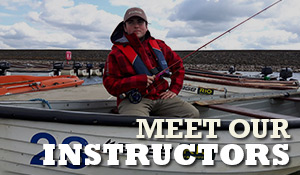Well, after what seems a lifetime of not being out on the water we are finally back and the fish have been feeding hard during our time away, resulting in them being in great condition and fighting hard. Now we are back, lots of anglers have reported good catches with fish coming to “The Hang”. The Hang can be a truly deadly method/technique which is often overlooked and not utterly understood by many anglers.
The hang can be fished from both the boat and the bank. However, it is most effective from the boat as the flies can be hung further away and over a greater depth. This often means the fish will not see the angler or the boat and often results in more positive takes.
In simple terms, “The Hang” is the act of presenting the flies static at the end of the retrieve before recasting. What the angler is unaware of is how much interest flies generate under the water; how many times have we you lifted your flies out of the water to recast only to find the a swirl on the water’s surface as a fish follows & turns away from your flies ..? To convert these follows into hook ups the angler must firstly assume that there are fish interested in the flies during every single retrieve. Secondly, the angler must give the fish the opportunity to take the flies by presenting them static prior to recasting. The angler can also greatly increase the likelihood of a take by generating further interest by a sharp rapid movement of the flies immediately prior the static phase of the hang.
For us to hang our flies effectively, we must know where our flies are in the water and how far they are away from the rod tip. To do this we use what is called a hang marker, a visible mark on the fly line. Most modern sinking fly lines come with hang markers already marked, although there are a few exceptions. The Airflo 40+ lines are excellent lines for sunken work, but they are missing a visible hang marker. For these & other Sinking Lines that do not possess in built hang markers we can mark our own hang markers.
We have already established that the Hang is conducted at the end of the retrieve, so our hang marker needs to be towards the end of the fly line. The distance away from the end of the fly line is very much personal preference; between 10 – 13ft seems to be the optimal distance. One hang marker is sufficient and can be used to repeat the process; hang once when the marker is at the rod tip and then again when the marker is at the hands, increasing the likelihood of a take even further.
So how do we make our own hang marker…? Over the years I have known anglers use numerous methods to mark their fly lines; from the use of permanent marker pens to whipping fluorescent floss onto the fly and then coating it in a UV Resin to protect it. The method of whipping floss will also provide the angler with an additional physical reminder as it is felt entering the tip ring. Whichever method is used, the marker needs to clearly visible so the angler cannot miss it.

The hang is often associated with sunk line fishing and often this is when it is most effective as often the flies are fished deep and fast which causes the fish to follow often all the way to the boat. This is where the hang can be devastating as stopping the flies just before recasting can cause any following/unsure fish to grab hold. However, it can be just as effective on a midge tip or floating line, with a team of nymphs where each fly is slowly drawn up to the surface.
When hanging flies, a lot of anglers simply hold the leader and flies in the water either in front of the boat or by the side of the boat for a couple of seconds. However, this is not the most effective. As previously mentioned, the hang works so well from the boat over deeper water when the fish do not see the boat or the angler. This therefore means on the boats hanging with some level of fly line still in the water can often yield the best results. Thankfully, fly line manufacturing companies have recognised the effectiveness of the hang and need for the process to be repeatable so have added hang markers on the lines. With both Airflo & RIO having their own different markers on the lines, so that the process can be replicated with accuracy on every cast.
The Airflo hang marker has several markers on the lines so that the hang can be done at various process along the cast. This can be deadly when the fish are coming a little short and following right up to the boat. This markers enable you to retrieve until half way back and then you can pause the fly to see if the stop induces a take, and then if not carry on until the next mark and so on until you find the stopping point the fish will want.

Here you can see the colour change of a Airflo Di3 coming to the rod tip indicating 10ft of line left. These subtle colour changes are all the way along the line to allow you to fish the hang at different points.
RIO have a very neat small section for a hang marker at 20ft, this enable you to stop at either 20ft and hang keeping the flies deep or drop them to 15ft with the marker halfway down the rod. Then also at 10ft and 5ft.

When it comes to the hang the best option is to experiment which depth, they would like the flies to be hung. Some days it will be 20ft other days it will be 5ft just as the flies come towards the surface. The best way is to hang to the first marker so lets us the RIO as an example, retrieve to 20ft then stop and hold the marker at the tip. Leave the flies hang dead stop for around 15 seconds

After the flies have been hung for 15 seconds do a slow figure of eight retrieve until 15ft and then repeat until either a fish has taken or you have found the depth the fish want the flies hung. I often find that 15ft is a great depth for sunk line work. However, do not be too quick to recast this can be the best part of the cast on some days and where most of the fish will take.

Then Finally you can figure of eight the line all the way into your hand giving you the ability to then hang your flies 10ft from the boat.

The hang can also be deadly on midge tip lines and floaters, especially when fishing a washing line deep or on deep buzzers. The key with this is just to slowly draw the flies up and hang them normally with about a rod length of fly line and just hold the fly’s static. This slow raise of the flies can be deadly as its just a subtle change of angle the fish has not seen on the retrieve back to the boat.

Fishing the hang off using a midge tip long.
On your next trip try these “Hang” tips and see if they can convert more fish into the boat.
Tightlines Tom Bird

